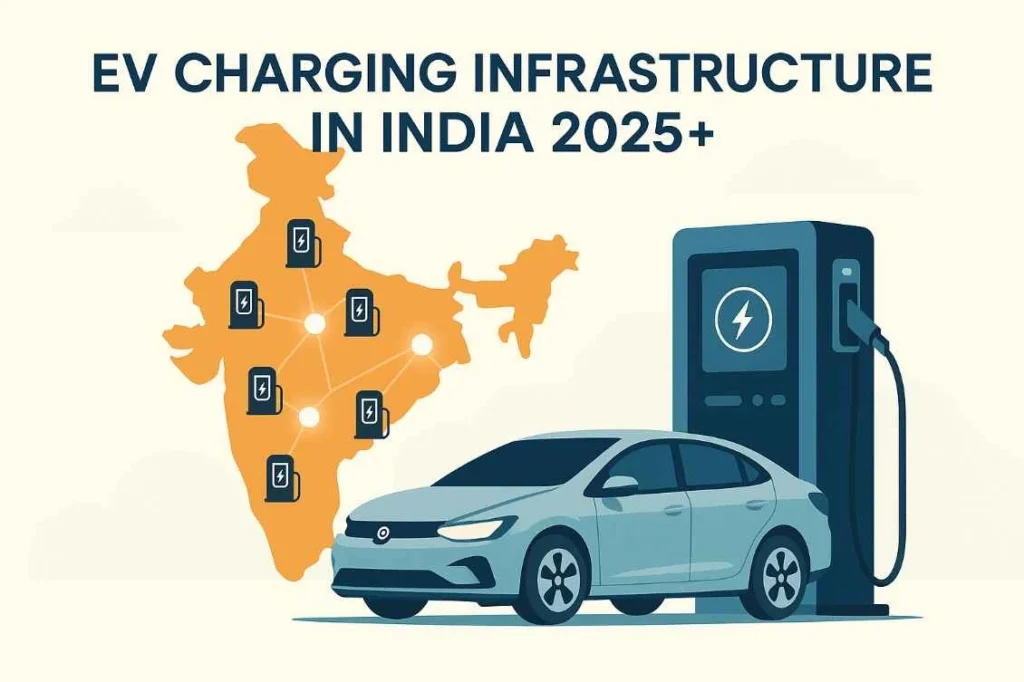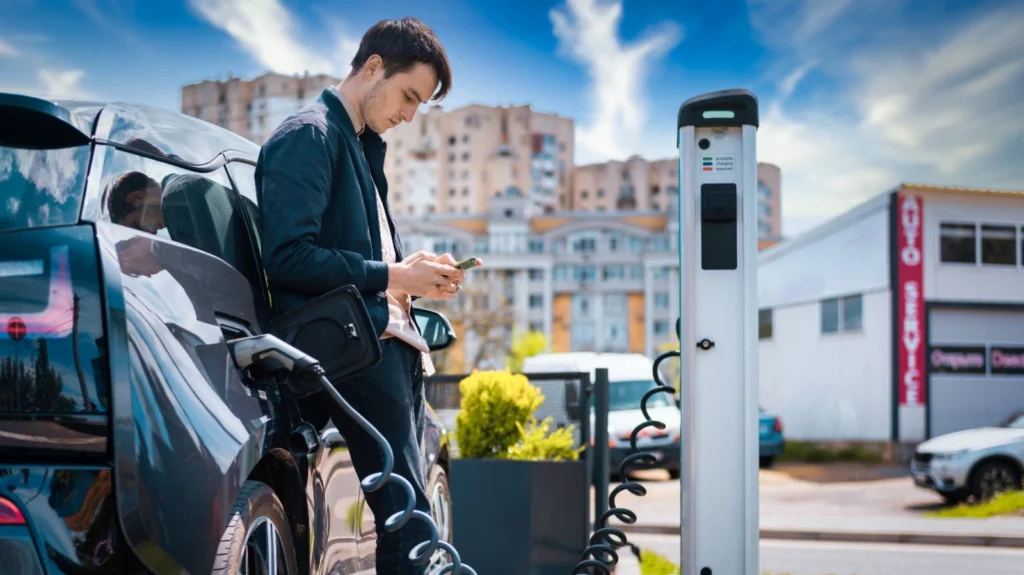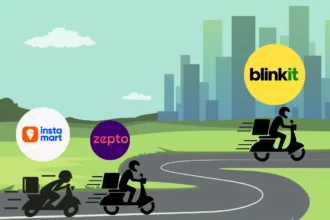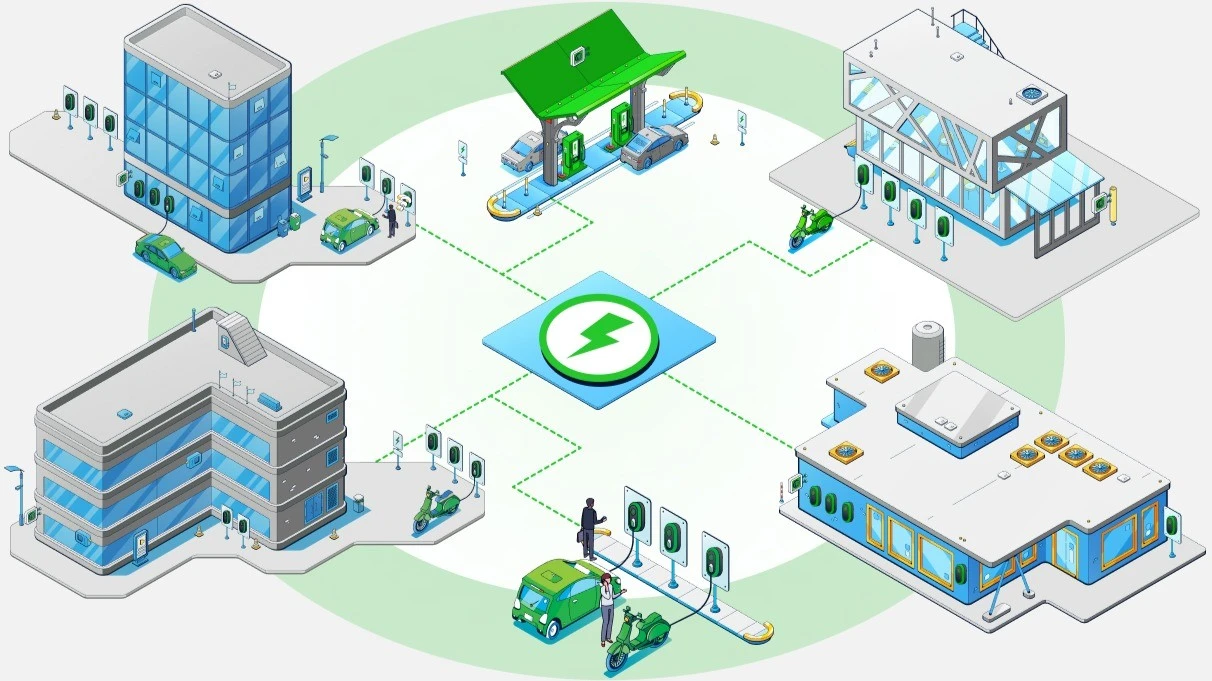Estimated Reading Time: 22-27 minutes (4,917 words)
Introduction
India’s transition to electric mobility is no longer a distant vision — it’s an ongoing transformation fueled by active policy, large-scale investment, and growing consumer awareness. As climate goals tighten and fuel prices fluctuate, EV adoption is becoming both an environmental and economic necessity. For Indian drivers, convenience and charging access are now just as crucial as affordability. Fleet operators and logistics startups are seeking reliable depot charging solutions, while investors are eyeing the high-growth EV infrastructure sector as the next frontier in clean energy returns.
The core enabler connecting all these stakeholders — from drivers and manufacturers to city planners and policymakers — is charging infrastructure. Without a robust network of interoperable, accessible, and grid-integrated charging stations, the EV dream can’t scale. Today’s ecosystem includes public fast-chargers on highways, home and workplace AC units, renewable-powered hubs, and app-based interoperability platforms, all working together to make EVs viable at scale.
This article brings together the latest industry data, case studies, and policy updates to show how India’s charging infrastructure is evolving — and where the biggest opportunities lie for entrepreneurs, investors, and even digital creators looking to capture the EV content and affiliate niche. Key data sources include the Ministry of Power, PM E-DRIVE initiative, and international benchmarks from the International Energy Agency (IEA) and PIB (pib.gov.in).

Quick Stats & Highlights (2024–2025)
1️⃣ National Growth Snapshot (India)
- As of August 1, 2025, India has installed ~29,277 public EV charging stations, according to the Ministry of Power (MoP) and PIB (pib.gov.in).
- This represents a 10x jump from 2022, when fewer than 3,000 public chargers were operational.
- Major urban centers — Delhi NCR, Mumbai, Pune, Bengaluru, and Hyderabad — account for over 60% of total chargers.
- The government and private sector are now focusing on highway corridors and Tier-2/Tier-3 cities to close the accessibility gap.
2️⃣ Global Context (IEA 2024–2025 Data)
- Over 1.3 million new public charging points were added globally in 2024, a 30% YoY increase, as per the International Energy Agency (IEA).
- Fast and ultra-fast DC chargers saw the strongest growth, reflecting global demand for rapid recharging.
- China, Europe, and the U.S. lead the global network, collectively hosting over 80% of installed charging stations.
- India’s growth rate is among the top five fastest globally, though total density remains lower compared to developed markets.
3️⃣ Government Funding & Policy Support
- The PM E-DRIVE Programme has allocated ₹2,000 crore exclusively for public charging infrastructure.
- The initiative targets tens of thousands of new chargers, including slow AC, fast DC, and ultra-fast stations, to be installed between 2025 and 2028.
- Additional policy support includes GST reductions, land allocation in public spaces, and FAME II subsidies for infrastructure developers.
- India’s broader EV policy roadmap aims to achieve 30% EV penetration by 2030.
4️⃣ Industry & Corporate Expansion
- Tata Power, Statiq, ChargeZone, Indian Oil (IOCL), and BPCL are rapidly expanding their networks across highways, malls, and residential complexes.
- Tata Motors (Reuters, 2025) announced a major nationwide fast-charging expansion plan linked to its dealerships and fleet customers.
- BPCL’s “E-Drive” and IOCL’s “EV-Ready Petrol Pumps” are converting traditional fuel stations into hybrid energy hubs.
- Renewable-powered chargers (especially solar) are gaining traction for both sustainability and cost-efficiency.
5️⃣ Key Takeaways (India’s EV Charging Momentum)
- 📊 Installed base: ~29,277 public chargers in India (Aug 2025).
- 🌍 Global benchmark: 1.3M+ public chargers added globally in 2024 (+30% YoY).
- 💰 Funding: ₹2,000 crore under PM E-DRIVE for charging infrastructure.
- ⚡ Private sector push: OEMs + energy firms building highway and city fast-charging grids.
- 🔮 2030 Outlook: India needs 500,000–1,000,000 chargers by 2030–2035 to sustain EV adoption growth.
Where Chargers Are Today — State and City Patterns
India’s EV charging ecosystem has developed in clusters, largely reflecting where EV adoption and infrastructure investment first took root. The landscape today (2025) shows strong concentration in urbanized and high-income states, while highway networks and smaller cities are still catching up.
1️⃣ Clustered Growth: Metro-Dominated Installations
- As of 2025, Karnataka, Maharashtra, Delhi, Tamil Nadu, and Gujarat account for over 65% of India’s total public chargers.
- Bengaluru (Karnataka) remains one of India’s largest EV hubs, hosting thousands of public and semi-public stations, thanks to early adoption policies and strong EV penetration among two-wheelers and fleet operators. (Source: ETAuto.com, 2025)
- Maharashtra (Mumbai–Pune corridor) and Delhi NCR have seen major deployments led by Tata Power, Statiq, and BPCL, supported by state EV policies and DISCOM partnerships.
- Tamil Nadu is rapidly emerging as a manufacturing + charging hub, with Chennai and Coimbatore witnessing large EV industrial clusters.
- Despite policy interest, PPP tenders (Public–Private Partnerships) in lower-demand regions (e.g., parts of Uttar Pradesh, Bihar, and North-East) have struggled due to low commercial viability and uncertain footfall.
2️⃣ Highway & Corridor Expansion: Still a Work in Progress
- The government’s PM E-DRIVE and National Highways Authority of India (NHAI) initiatives are focused on developing EV-ready corridors across key expressways like the Delhi–Mumbai Expressway, Bengaluru–Hyderabad Highway, and Golden Quadrilateral routes. (Source: pib.gov.in)
- Oil PSUs such as IOCL, BPCL, and HPCL are leading efforts to retrofit fuel stations with fast DC chargers, turning them into hybrid “energy hubs.”
- Despite progress, continuous fast-charging coverage for long intercity travel is still limited. Most highway chargers today are spaced 70–120 km apart, leaving “charging deserts” between smaller towns.
- The next policy phase emphasizes cluster-to-corridor connectivity, ensuring consistent charger availability every 40–50 km by 2028.
3️⃣ Two-Wheeler vs. Four-Wheeler Infrastructure Focus
- India’s EV market remains two-wheeler dominated, and charging patterns reflect that.
- A large proportion (approx. 60% of installed points) are slow or AC chargers serving e-scooters, e-rickshaws, and three-wheelers, especially in cities like Delhi, Pune, and Bengaluru.
- Fleet depots and commercial hubs use overnight AC charging as their primary solution — cost-effective and suitable for vehicles with smaller batteries.
- In contrast, fast and ultra-fast DC chargers are concentrated around urban arterial roads, highways, and premium real estate zones, targeting four-wheelers, taxis, and delivery fleets.
- Several startups are also piloting battery-swapping stations for two-wheelers, a segment projected to become a $1.2 billion market by 2030. (Source: NITI Aayog / IEA projections)
🔑 Key Takeaways
- Metros Lead the Charge: Karnataka, Maharashtra, Delhi, Tamil Nadu, and Gujarat dominate current EV charging density.
- Highways Are the Next Frontier: Major expansion underway through PM E-DRIVE and PSU-led corridors, but gaps persist between smaller towns.
- Urban Two-Wheeler Priority: Most chargers still cater to e-scooters and rickshaws, while fast DC units for cars and fleets are growing selectively.
- Investment Opportunity: Tier-2 cities and intercity highways represent the next growth wave for private charging operators and startups.
Key Policies & Schemes (What Has Changed Recently)
India’s EV charging revolution isn’t just market-driven — it’s policy-enabled. A series of central and state-level interventions since 2019 have built the foundation for charging infrastructure growth, but the most transformative policy shifts have occurred between 2023 and 2025. These updates reflect India’s move from pilot projects to mass deployment, with a strong focus on public charging access, fast chargers for 4-wheelers, and electrification of commercial and public transport fleets.
1️⃣ FAME-II (Legacy Scheme – Foundation Phase, 2019–2024)
- The FAME-II (Faster Adoption and Manufacturing of Hybrid & Electric Vehicles) scheme, implemented by the Department of Heavy Industries (DHI), played a pivotal role in India’s early EV infrastructure rollout. (Source: energetica-india.net)
- It provided capital grants, demand incentives, and subsidies for:
- Electric two-wheelers, three-wheelers, and buses.
- Setting up public charging stations across major cities and highways.
- Electric two-wheelers, three-wheelers, and buses.
- Under FAME-II, over 2,800 charging stations were sanctioned across 68 cities, creating India’s first structured network of public chargers.
- The program also mandated standardized connectors and communication protocols, paving the way for future interoperability.
- While the scheme officially sunsetted in 2024, its outcomes serve as the baseline for PM E-DRIVE, India’s next-generation EV infrastructure mission.
2️⃣ PM E-DRIVE (Flagship National Programme, Launched October 1, 2024 — Ongoing)
- The PM E-DRIVE (Electric Drive Revolution for Indian Vehicles & Ecosystem) is India’s central sector EV mission, launched to accelerate adoption and create a nationwide charging backbone. (Sources: pmedrive.heavyindustries.gov.in | pib.gov.in)
- The scheme integrates demand-side incentives, manufacturing support, and public infrastructure targets into one unified framework.
- Core objectives include:
- Deployment of 22,100 fast chargers for electric 4-wheelers (e-4W).
- Installation of ~1,800 dedicated chargers for electric buses, including depot and terminal-level units.
- Rollout of tens of thousands of slow/medium chargers for two- and three-wheelers, especially in urban and semi-urban regions.
- A budget allocation of ₹2,000 crore for the public charging infrastructure component alone.
- Deployment of 22,100 fast chargers for electric 4-wheelers (e-4W).
- Scheme timeline: Initially set from Oct 2024 to March 2026, but recent PIB releases (2025) indicate operational extensions to include electric trucks, ambulances, and institutional fleet electrification.
- Operational goals:
- Promote PPP models to attract private players.
- Ensure pan-India charger coverage across cities, towns, and major national highways.
- Create a central monitoring dashboard for charger mapping, uptime tracking, and tariff regulation.
- Promote PPP models to attract private players.
The scheme represents India’s first comprehensive EV infrastructure framework, aligning with the 2030 decarbonization roadmap.
Charging Types, Technologies & Where They Fit in India’s EV Ecosystem
India’s EV charging network is evolving rapidly — but it’s not one-size-fits-all. Different charger types serve specific use cases depending on vehicle category, location, power demand, and dwell time. Understanding these distinctions is crucial for consumers, investors, and site operators planning EV infrastructure projects.
1️⃣ AC Slow Chargers (3.3–7 kW)
- Use case: Ideal for home garages, office parking lots, and small fleet hubs.
- Vehicle focus: Two-wheelers (2W), three-wheelers (3W), and private electric cars.
- Charging time: 6–10 hours for a full charge (typical overnight use).
- Advantages:
- Low CAPEX (capital expenditure) — easier to install.
- Convenient for users with long parking durations.
- Compatible with existing electrical infrastructure.
- Low CAPEX (capital expenditure) — easier to install.
- Example: Most residential chargers from OEMs like Tata Motors or MG Motor India fall in this range.
- Market insight: As of 2025, AC slow chargers dominate urban and residential adoption, especially among first-time EV buyers.
2️⃣ AC Fast Chargers (11–22 kW)
- Use case: Mid-speed charging for apartments, malls, offices, and gated communities.
- Vehicle focus: Passenger cars and commercial 3/4-wheelers.
- Charging time: 3–5 hours depending on vehicle battery size.
- Advantages:
- Higher throughput than slow chargers — good balance between cost and speed.
- Supports multiple users per day in semi-public spaces.
- Compatible with Type-2 connectors (India’s common AC standard).
- Higher throughput than slow chargers — good balance between cost and speed.
- Example: Installed in tech parks and shopping malls as part of urban smart infrastructure projects (e.g., in Bengaluru and Pune).
- Market note: Increasingly adopted in smart city projects supported by MoHUA and private DISCOM partnerships.
3️⃣ DC Fast Chargers (50 kW)
- Use case: Core of public charging networks and fleet depots.
- Vehicle focus: Four-wheelers (4W) — cars, taxis, and light commercial vehicles (LCVs).
- Charging time: Typically 40–60 minutes for an 80% charge.
- Advantages:
- Enables short dwell-time charging — perfect for on-the-go users.
- Suitable for high-traffic locations like fuel stations, logistics hubs, and airports.
- Increasingly supported under the PM E-DRIVE program for intercity and public charging corridors.
- Enables short dwell-time charging — perfect for on-the-go users.
- Example: Tata Power, Statiq, and ChargeZone operate several 50–60 kW DC stations along major corridors (Delhi–Mumbai, Chennai–Bengaluru).
- SEO note: Keywords like “DC fast charger cost in India” and “50 kW public charging station setup” have high search volume.
4️⃣ Ultra-Fast Chargers (120 kW and Above)
- Use case: Highway corridors and expressways for long-distance travel.
- Vehicle focus: Premium 4W EVs, buses, and heavy-duty electric trucks.
- Charging time: 15–30 minutes for 80% battery capacity.
- Advantages:
- Essential for intercity and long-haul EV adoption.
- Reduces “range anxiety” for cross-country routes.
- Requires strong grid connections and load management systems.
- Essential for intercity and long-haul EV adoption.
- Example: Tata Power’s “Mega Charger” concept (Reuters, 2025) — an ultra-fast charging solution targeting expressway corridors and heavy-duty fleets.
- Market trend: Ultra-fast charging hubs are being co-located with renewable energy farms and battery storage units to offset peak grid demand.
5️⃣ Battery Swapping Stations
- Use case: Primarily for commercial 2W/3W fleets, delivery riders, and urban logistics.
- Vehicle focus: Electric scooters, rickshaws, and light delivery vehicles.
- Advantages:
- Instant turnaround — batteries swapped in under 3 minutes.
- Reduces downtime for fleets operating on tight delivery schedules.
- Lower upfront cost for users (battery leasing model).
- Instant turnaround — batteries swapped in under 3 minutes.
- Example: SUN Mobility, Gogoro, and Bounce Infinity are leading swapping operators in India.
- Limitations:
- Standardization challenges — different OEMs use varying battery chemistries and sizes.
- Not yet widely viable for passenger EVs due to high cost and limited interoperability.
- Standardization challenges — different OEMs use varying battery chemistries and sizes.
- Policy note: Supported under the Battery Swapping Policy (Draft, NITI Aayog) for fleet electrification.
6️⃣ Smart Chargers & V2G (Vehicle-to-Grid) Technology
- Use case: Integration of chargers with smart grids, renewable energy systems, and storage management.
- Technology features:
- Dynamic load balancing and time-of-use (ToD) pricing.
- Energy feedback (V2G) — EVs can discharge stored power back to the grid during peak hours.
- Enables remote monitoring, billing, and predictive maintenance.
- Dynamic load balancing and time-of-use (ToD) pricing.
- Advantages:
- Reduces grid stress and enables green energy optimization.
- Positions EVs as mobile energy assets, not just vehicles.
- Reduces grid stress and enables green energy optimization.
- Example: Pilots underway in Delhi NCR, Pune, and Hyderabad under DISCOM–tech partnerships.
- Future outlook: Smart chargers will play a key role in urban microgrid projects and renewable integration under India’s Smart City 2.0 framework.
🔑 Key Takeaways
- AC Slow & Fast chargers dominate homes and workplaces — low cost, high adoption.
- DC Fast & Ultra-Fast chargers are the backbone of public and highway infrastructure, enabling quick turnaround times.
- Battery swapping is rising in commercial 2W/3W segments, not yet mainstream for cars.
- Smart & V2G chargers represent the next tech wave — blending charging with energy management and grid intelligence.

Cost economics — home charging vs public fast charging
(Short worked examples + calculator logic you can convert into a downloadable lead magnet.)
Assumptions (example)
- Electricity tariff (residential): ₹8 / kWh (varies by state/time).
- Public DC fast charging price: ₹25–40 / kWh (varies by operator).
- EV efficiency: 6 km/kWh (typical for small EV) to 4 km/kWh (heavier vehicles).
Example: cost per km
- Home charging cost per km at ₹8/kWh and 6 km/kWh → ₹8 ÷ 6 = ₹1.33 / km.
- Public fast charging cost at ₹30/kWh and 6 km/kWh → ₹30 ÷ 6 = ₹5.00 / km.
Payback and behavior
- Drivers with reliable overnight home charging (apartment with dedicated socket or home wallbox) will have much lower operating costs.
- Public fast charging is premium: useful for long trips or topping up, but higher per-km cost. Fleet operators should plan depot charging (cheaper, scheduled) vs opportunistic DC fast charging.
SEO/affiliate hooks: Create a downloadable “EV Charging Cost Calculator (India)” as a lead magnet — capture emails by asking users to input their city tariff, vehicle efficiency and estimated km/month to get a custom cost breakdown.
Sources & guidance: Use state tariffs, operator price lists and MoP charger type guidance when building calculators. pib.gov.in+1
Business models for site owners & fleets (practical, monetizable content)
Who can profit: petrol stations, mall parking, corporate offices, fleet depots, telecom towers (as landholders), and local municipalities.
Typical revenue streams
- Per-kWh charging revenue — core.
- Subscription/ membership — bundle discounted kWh or priority access.
- Value-add services — coffee shop, quick maintenance, solar+storage rentals.
- Ad & affiliate income — display ads in charging app, partner promos.
CAPEX/OPEX snapshot (example, indicative)
- AC Wallbox (home/work): ₹25k–₹70k installed.
- 50 kW DC fast charger: ₹8–15 lakh (hardware) + installation & grid upgrade costs.
- 120 kW+ ultra-fast site: ₹30 lakh+ plus grid upgrades & transformer capacity.
- OPEX: energy cost, site lease, maintenance, communications & payment gateway, network fees.
Subsidies & support
- PM E-DRIVE and some state schemes provide viability gap funding, concessional grants or capital subsidies for public charger deployment. Eligibility, paperwork and reimbursements must be followed closely. pmedrive.heavyindustries.gov.in+1
Monetization opportunities for your blog: Affiliate referrals to charger manufacturers, installers, solar+storage suppliers; sponsored posts for CPOs (Charge Point Operators); downloadable B2B “How to set up a charging station” kit (paid).
10-Year Outlook (2025 → 2035) — Scenarios & Projections
The next decade will define the scale and maturity of India’s EV charging infrastructure. Between 2025 and 2035, the country is expected to witness exponential growth driven by a mix of policy incentives, private investment, and technology evolution. Drawing from the International Energy Agency (IEA) Global EV Outlook 2024, Government of India targets, and industry forecasts, three plausible growth scenarios emerge — each representing different levels of policy intensity, private participation, and grid readiness.
1️⃣ Conservative Scenario — Steady, Policy-Only Growth
- Under a “business-as-usual” trajectory, India’s EV charging network expands organically, relying primarily on existing FAME-II and PM E-DRIVE allocations without major policy shocks or aggressive state intervention.
- Public charging stations could increase from ~29,000 in 2025 to 200,000–400,000 by 2030, driven by metro demand, urban fleet electrification, and corporate sustainability targets.
- EV market share of new vehicle sales would rise modestly, reaching around 20–25% by 2030 (IEA estimate), with two-wheelers and e-rickshaws dominating.
- However, grid bottlenecks, land access issues, and low utilization rates in smaller cities could slow the expansion of fast and ultra-fast DC charging corridors.
- This path delivers predictable but slower ROI, favoring steady, policy-backed operators like Tata Power and IOCL over high-risk startups.
2️⃣ Policy-Driven / Targeted Scenario — The Likely Path
- This is considered the most probable outcome under India’s current trajectory of strong central and state coordination.
- With PM E-DRIVE in full effect, continued support for battery-swapping ecosystems, and the conversion of fuel pumps into multi-energy hubs, India could achieve between 500,000 and 1.3 million public chargers by 2030.
- Urban areas would see dense fast-charger networks (every 2–3 km in Tier-1 cities), while intercity highways develop EV-ready corridors with 50–100 km spacing between chargers.
- Global context: According to the IEA’s Central Scenario, worldwide public charging points are projected to exceed 15 million by 2030, with Asia-Pacific (especially China and India) leading deployment.
- India’s share will depend heavily on EV penetration rates, state-level policy execution, and private operator participation (e.g., Tata Power, Statiq, BPCL, ChargeZone).
- Energy integration also strengthens — chargers start linking with renewable power sources and battery storage for grid balancing.
- This scenario positions India as a regional EV infrastructure hub, attracting foreign direct investment (FDI) and EV-tech collaborations.
3️⃣ Optimistic / Fast Adoption Scenario — Accelerated Electrification
- In this high-growth pathway, India embraces mass-scale electrification across two-wheelers, commercial fleets, buses, and passenger EVs.
- Public and private charging installations cross 1 million units by 2030, potentially reaching 2–3 million by 2035, matching national EV sales growth exceeding 40–50% of new vehicle sales.
- Smart grids, energy storage systems (ESS), and AI-based demand management become mainstream, enabling fast-charging density without grid overload.
- Oil PSUs pivot fully to “multi-energy stations”, combining petrol, EV charging, hydrogen, and CNG — transforming India’s fueling landscape.
- Private capital flows into Charging-as-a-Service (CaaS) and subscription-based home charging solutions, while battery swapping networks scale rapidly in urban clusters.
- The result: a nationally integrated EV ecosystem, creating thousands of new jobs, reducing imported fuel dependency, and boosting India’s climate goals under COP commitments.
- (Sources: IEA Global EV Outlook 2024, Reuters Automotive, NITI Aayog EV Roadmap, PIB releases on PM E-DRIVE)
🔑 Key Drivers Across All Scenarios
- OEM Network Expansion: Tata Motors, Mahindra, and Hyundai are jointly investing in charger deployment ecosystems for customers.
- Oil-PSU Transformation: BPCL and IOCL converting 20,000+ fuel stations into hybrid energy outlets.
- Grid Modernization: Smart metering and storage integration to handle EV load peaks.
- State-Level Facilitation: Maharashtra, Karnataka, and Delhi leading with land allocation, tariff rationalization, and license-free charger operations.
- Private Sector Innovation: Startups (Statiq, ChargeZone, EVRE, BluSmart) scaling with asset-light franchise and pay-per-use models.
🧭 Outlook Summary (2025–2035)
- India’s EV charging market could grow 20–30x in a decade.
- A balanced mix of policy support, private investment, and technology will determine whether India meets or exceeds 1 million public chargers by 2030.
- Regardless of the scenario, EV infrastructure will emerge as one of India’s most dynamic green economy segments, comparable in scale to telecom expansion two decades ago.
Risks & roadblocks (what could slow growth)
- Grid constraints & transformer capacity at high-power sites raise installation costs.
- Land / permits / local approvals can delay rollouts; PPP tenders have sometimes failed due to commercial risks (example: Karnataka PPP tender failures). The Times of India
- Uneven demand outside metros risking underutilization for some private CPOs.
- Interoperability & roaming fragmentation can confuse users if payments/authorization aren’t smooth.
- High upfront CAPEX for ultra-fast sites — requires scale or bundled renewable + storage to make returns.
FAQs Section
1. How many public EV chargers does India have in 2025?
As of August 1, 2025, India has approximately 29,277 operational public EV charging stations, according to the Ministry of Power (MoP) and Press Information Bureau (PIB).
This marks an exponential rise from just 4,900 stations in 2022, reflecting the combined impact of FAME-II incentives, PM E-DRIVE funding, and private sector expansion by players such as Tata Power, Statiq, and BPCL.
(Source: pib.gov.in, Ministry of Power updates 2025)
2. What is PM E-DRIVE and does it fund EV chargers?
PM E-DRIVE (Promoting e-Mobility and Deployment of Reliable Infrastructure for Vehicle Electrification) is a central government scheme launched on October 1, 2024, designed to accelerate EV adoption and charging infrastructure rollout across India.
Key features include:
- ₹2,000 crore specifically allocated for public charging infrastructure.
- Targets: 22,100 fast chargers for 4-wheelers, ~1,800 for e-buses, and tens of thousands for 2W/3W segments.
Support for testing, quality standards, and interoperability frameworks.
The scheme’s operational period runs till March 2026, with possible extensions to include electric buses, ambulances, and trucks.
(Sources: pmedrive.heavyindustries.gov.in, pib.gov.in, Ministry of Heavy Industries 2025)
3. Should I install a home charger or rely on public chargers?
- If you have dedicated overnight parking (garage or apartment slot), installing a home AC wallbox (3.3–7 kW) is cheaper and more convenient.
- Public DC fast chargers (50–60 kW) are ideal for long-distance travel or emergency top-ups.
Fleet operators or shared mobility users should consider depot or workplace chargers for cost efficiency.
💡 Tip: You can use our EV Charging Cost Calculator (Lead Magnet PDF) to compare home vs. public charging costs per km.
4. What’s the cost to install a 50 kW DC fast charger in India?
- Hardware cost: ₹8–15 lakh depending on make, import duties, and configuration.
- Installation + civil work: ₹3–6 lakh (foundation, cabling, transformer connection).
Grid upgradation (if required): ₹5–10 lakh additional for higher load.
Thus, a full setup typically costs ₹15–30 lakh per charging point.
Payback depends on location throughput (no. of sessions/day) and subsidy availability.
(Source: ResearchGate 2025, industry estimates)
5. Who are the major players building EV charger networks in India?
India’s charging ecosystem is being developed through public-private collaboration involving:
- OEMs: Tata Motors, Mahindra, Hyundai, MG Motor (dealer & customer network charging).
- Utilities: Tata Power, BSES, CESC, BESCOM.
- Oil PSUs: IOCL, BPCL, HPCL — converting fuel stations into “multi-energy hubs.”
- Private CPOs (Charge Point Operators): Statiq, ChargeZone, EVRE, Zeon Charging, Ather Grid.
- Startups & Tech Enablers: Bolt.Earth, Exicom, Sun Mobility (battery swapping).
- (Sources: Reuters Automotive, ETAuto, Company Investor Reports 2025)
6. How fast will fast chargers grow in India?
Between 2025 and 2030, DC fast chargers (50 kW and above) are projected to grow 10–15x, driven by:
- PM E-DRIVE funding and NHAI corridor rollouts.
- OEM partnerships bundling chargers with EV sales.
Oil PSUs deploying 20,000+ fast chargers at fuel outlets.
Globally, the IEA projects over 15 million public charging points by 2030, with Asia-Pacific (China & India) accounting for the majority.
(Source: IEA Global EV Outlook 2024, pib.gov.in)
7. Is battery swapping viable in India?
Yes — but primarily for 2W/3W commercial fleets, where uptime and turnaround are critical.
- Swapping reduces downtime to under 3 minutes compared to hours of charging.
Fleet-based subscription models (e.g., SUN Mobility, Bounce Infinity) make it cost-efficient.
However, passenger car swapping faces standardization and safety challenges.
NITI Aayog’s Battery Swapping Policy (Draft) aims to address interoperability and certification.
(Source: sciencedirect.com, NITI Aayog 2025)
8. Are there subsidies or incentives to set up public chargers?
Yes. Several central and state-level incentives exist:
- PM E-DRIVE: ₹2,000 crore for charger installation (public/private).
- FAME-II: Grants for up to 70% of charger hardware cost in eligible cities.
- State Policies:
- Delhi: Capital subsidy on land lease and electrical infrastructure.
- Maharashtra & Karnataka: Reduced electricity tariffs and license-free installation. Entrepreneurs should consult state nodal agencies (BEE, DISCOMs) for current updates.(Source: pib.gov.in, State EV Policy Portals, 2025)
- Delhi: Capital subsidy on land lease and electrical infrastructure.
9. Will charging my EV increase my home electricity bill?
Yes, home charging increases your electricity consumption, but it’s still cheaper than fuel.
- Example: Charging an EV for 1,000 km may consume 150–200 kWh/month, adding roughly ₹1,200–₹1,800 to your bill (depending on tariff).
- Using time-of-day (ToD) or off-peak rates reduces cost by 10–20%.
Some DISCOMs (like Tata Power, BSES) offer dedicated EV meters or concessional tariffs.
(Source: IEA 2024, State DISCOM tariff notifications)
10. Is investing in EV chargers profitable for petrol pumps or malls?
Yes — but profitability depends on location, traffic volume, and utilization rate.
- Highway stations and fleet depots (high throughput) can earn ROI in 3–5 years.
- Urban low-usage stations may take longer (6–8 years) unless paired with retail or F&B services.
Bundling chargers with restaurants, parking, or advertising can increase per-session revenue by 20–30%.
Fast-charging hubs (60–120 kW) are emerging as anchor businesses for malls and hotels targeting EV audiences.
(Sources: The Times of India, Bloomberg NEF, 2025)
11. Which cities in India have the most chargers (as of 2025)?
The top-performing states and cities include:
- Karnataka (Bengaluru) – early leader with thousands of chargers.
- Maharashtra (Mumbai, Pune) – strong public-private expansion.
- Delhi NCR – advanced policy and public fleet integration.
Tamil Nadu (Chennai) and Gujarat (Ahmedabad) – rising EV industrial clusters.
Emerging hotspots include Hyderabad, Kochi, and Lucknow, with rapid installations under Smart City projects.
(Source: ETAuto, MoP/BEE EV dashboards 2025)
12. How can startups or small businesses enter the EV charging sector?
- Franchise or partnership models: Work with CPOs like Statiq, Zeon, or Tata Power EZ Charge.
- Site leasing: Offer your land or parking lot for shared revenue.
- Value-add services: Build software (apps, analytics, billing) for charger management.
- Government tenders: Participate in PM E-DRIVE or Smart City EV projects. (Source: Invest India, Startup India, 2025)
13. What challenges still limit EV charging growth in India?
- Grid capacity constraints in semi-urban areas.
- High upfront costs for DC fast chargers.
- Land acquisition and utility coordination delays.
- Low charger utilization (<15%) in early stages of deployment.
- Need for unified interoperability standards across OEMs and operators. (Sources: IEA, NITI Aayog, PwC EV Infrastructure Report 2025)
14. What future technologies will shape EV charging by 2030?
- Vehicle-to-Grid (V2G) integration for smart energy feedback.
- AI-based load management and predictive maintenance.
- Wireless (inductive) charging for urban parking and buses.
- Solar + battery storage-powered stations for off-grid rural networks. (Source: McKinsey Future of Mobility Report 2025, IEA)
15. How much does it cost to install an EV charging station in India (2025)?
The cost depends on charger type, power rating, and setup complexity:
- Home AC Charger (3.3–7.4 kW): ₹50,000 – ₹1.25 lakh (hardware + installation).
- Commercial AC Charger (11–22 kW): ₹1.5 – ₹3 lakh.
- DC Fast Charger (30–60 kW): ₹8 – ₹15 lakh (hardware only).
- Total Setup (including transformer, civil work, permits): ₹15 – ₹30 lakh for public fast-charging.
💡 Pro Insight: Use “EV charging cost calculator” tools or government-approved CPO pricing references to give your readers interactivity.
(Sources: Ministry of Power 2025, Tata Power EZ Charge, ResearchGate Industry Reports)
16. Is PM E-DRIVE subsidy available for individuals?
The PM E-DRIVE scheme primarily funds public and semi-public infrastructure — such as charging stations at fuel pumps, fleet depots, malls, and highways.
However, individuals (private EV owners) can still benefit indirectly via:
- Discounted home chargers when bundled with EV purchases (by Tata, Hyundai, MG, etc.).
- Reduced GST (5%) on chargers and charging equipment.
- Possible state-level incentives (Delhi, Karnataka, Maharashtra) that offer rebates on home installation costs.
For businesses, PM E-DRIVE offers capital subsidy or viability gap funding (VGF) up to 40–60% on public charger setup costs.
(Sources: pmedrive.heavyindustries.gov.in, FAME-II notifications, State EV Policy 2025)
17. Which state has the best EV policy in India (2025)?
In 2025, several Indian states are leading EV adoption — each excelling in different aspects:
- Delhi: Strongest incentive mix — up to ₹10,000 per kWh battery subsidy, 100% road tax exemption, and simplified charger installation through Switch Delhi Portal.
- Karnataka: First-mover advantage with 1,000+ charging stations and EV manufacturing ecosystem in Bengaluru.
- Maharashtra: Focus on industrial EV hubs and charging corridor expansion under the MahaEV Policy 2025.
- Tamil Nadu: Aggressive EV manufacturing push — home to Ola, Ather, and BYD facilities.
💡 Pro Insight: If your audience is regional, mention state-specific benefits and links — this boosts local SEO and improves Google Discover visibility.
(Sources: State EV Policy Portals, BEE India, ETAuto 2025)
18. Can I earn money from EV chargers?
Yes — installing EV chargers can be a profitable micro-business if you choose the right model:
- Franchise Partnerships: Join networks like Tata Power EZ Charge, Statiq, or Zeon; share revenue per charging session.
- Land Monetization: Offer your parking space or property for hosting public chargers.
- Subscription/Pay-per-use Models: Charge EV owners hourly or per kWh; integrate UPI or RFID-based payments.
- Fleet Charging: Set up depot-based stations for e-rickshaws or delivery fleets with guaranteed daily usage.
Returns depend on:
- Location (highway vs. urban)
- Utilization rate (sessions/day)
Electricity tariff & subsidy coverage
On average, high-traffic chargers can yield ROI in 3–5 years.
(Sources: NITI Aayog 2025, Invest India EV Infrastructure Report, Times of India Business 2025)
Summary
- Explosive Growth: India now has 12,000+ public EV charging stations (as of 2025), marking a 5x rise since 2022, driven by strong government and private sector push.
- Policy Backbone: Schemes like FAME II, PLI for ACC batteries, and the National Electric Mobility Mission Plan (NEMMP) are fueling large-scale infrastructure expansion.
- Private Investment Surge: Major players such as Tata Power, Statiq, ChargeZone, and BPCL are developing nationwide charging corridors and urban charging grids.
- Renewable Integration: Many new charging hubs are now solar-powered, aligning with India’s green energy transition and carbon-neutrality goals.
- Consumer Impact: Wider availability of chargers is reducing “range anxiety,” making EV ownership practical across metros and Tier-2 cities.
- Future Outlook: India’s charging network is projected to grow 10x by 2030, supporting the national target of 30% EV penetration and creating vast opportunities in tech, real estate, and energy sectors.

Conclusion
India’s EV charging infrastructure has moved from infancy to growth phase: from a few thousand chargers in 2022 to ~29,277 public stations by August 1, 2025, driven by PM E-DRIVE policy, FAME-II legacy, OEM commitments and private sector action. However, to match expected EV adoption and avoid range-constraint bottlenecks, India needs an aggressive, coordinated push — fast chargers on highways, depot charging for fleets, home charging rollouts, and grid modernization. For content publishers and entrepreneurs, this creates a rich opportunity: practical local content, calculators, B2B guides and lead generation funnels will attract traffic and monetization.
If you want, I’ll now:
- Produce a city-by-city “Where to Charge” interactive post for top 10 Indian cities (highly monetizable).
- Or build the downloadable EV Charging Cost Calculator (India) and the gated lead magnet with integration texts and email templates.
Which one should I create next — the city maps (top 10 cities) or the charging cost calculator lead magnet?
References & Sources (key links cited)
- Ministry of Power / Press Release — EV charging stations installed across the country (PIB / MoP) — Aug 1, 2025. pib.gov.in
- PM E-DRIVE official site & guidelines. pmedrive.heavyindustries.gov.in+1
- IEA — Global EV Outlook 2025 / Electric vehicle charging (global charger additions 2024). IEA
- IEA — Outlook for EV charging infrastructure / 2030 projections. IEA
- PIB press release — PM E-DRIVE allocations & MoP updates. pib.gov.in
- Reuters — Tata Motors charging network expansion (Feb 2025). Reuters
- Economic Times / statewise data reporting on public chargers. ETAuto.com
- Additional industry & analyst commentary (Energetica-India, Exicom, research reports). energetica-india.net+1







